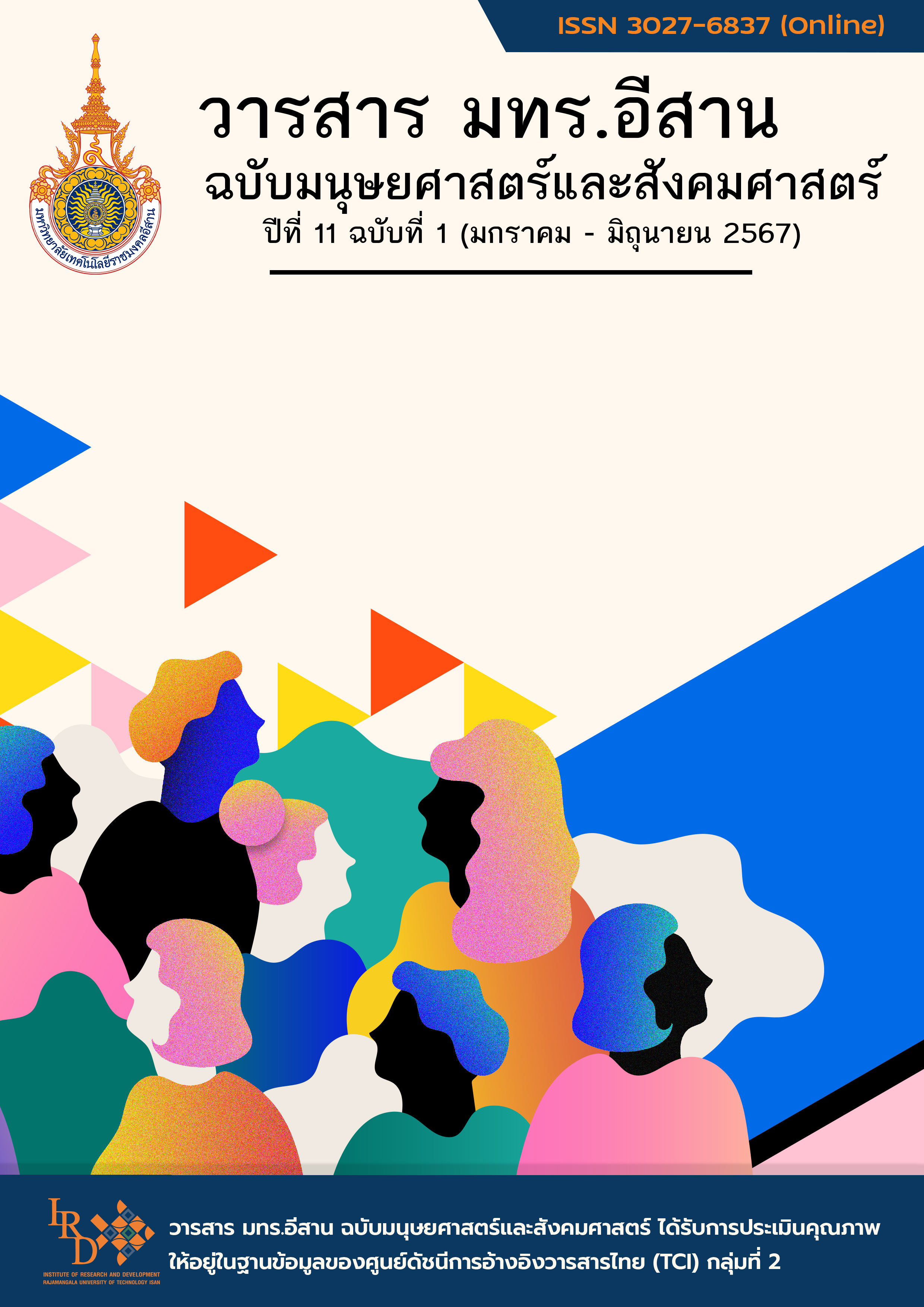Experiential Marketing, Satisfaction, and Place Attachment Affecting Chinese Tourism’s Revisit Intention to Chiangmai Province
Main Article Content
Abstract
The purposes of this study were to 1) study the opinion level of the experiential marketing, satisfaction, place attachment and Chinese tourism’s revisit intention to Chiangmai province and 2) to study the affecting the of the experiential marketing, satisfactions, and place attachment to Chinese tourism’s revisit intention to Chiangmai province. The sample comprised 385 Chinese tourism who have been to Chiangmai province. The research instrument was an online questionnaire. Data were analyzed by descriptive statistics using frequency, percentage, mean, standard deviation and interferential statistic using multiple regression analysis. The findings indicated that place attachment the experiential marketing, satisfaction, and Chinese tourism’s revisit intention to Chiangmai province were at a high level, with mean scores of 3.95, 3.95, 3.76 and 3.73, respectively. Place attachment, the experiential marketing, and satisfaction affect Chinese tourism’s revisit intention to Chiangmai province with statistical significance at the 0.05 level, with effect sizes of 0.491, 0.224 and 0.162, respectively. These predict the Chinese tourism’s revisit intention to Chiangmai province by 55.30 %. The departments involved in the tourism industry should implement experiential marketing strategies to cultivate satisfaction and foster a sense of place attachment to the area. This approach aims to encourage Chinese tourists to revisit Chiang Mai province.
Article Details

This work is licensed under a Creative Commons Attribution-NonCommercial-NoDerivatives 4.0 International License.
บทความที่ได้รับการตีพิมพ์เป็นลิขสิทธิ์ของมหาวิทยาลัยเทคโนโลยีราชมงคลอีสาน
ข้อความที่ปรากฏในบทความแต่ละเรื่องในวารสารวิชาการเล่มนี้เป็นความคิดเห็นส่วนตัวของผู้เขียนแต่ละท่านไม่เกี่ยวข้องกับมหาวิทยาลัยเทคโนโลยีราชมงคลอีสานและคณาจารย์ท่านอื่นๆในมหาวิทยาลัยฯ แต่อย่างใด ความรับผิดชอบองค์ประกอบทั้งหมดของบทความแต่ละเรื่องเป็นของผู้เขียนแต่ละท่าน หากมีความผิดพลาดใดๆ ผู้เขียนแต่ละท่านจะรับผิดชอบบทความของตนเองแต่ผู้เดียว
References
กัลยา วาณิชย์บัญชา. (2549). สถิติสำหรับงานวิจัย. พิมพ์ครั้งที่ 2. กรุงเทพฯ : ศูนย์หนังสือแห่งจุฬาลงกรณ์มหาวิทยาลัย
เกศสิริ ปั้นธุระ. (2556). การรับรู้คุณค่าและการตั้งใจซื้อซํ้าของผู้บริโภคต่อสินค้าอาหารโอทอป. วารสารพัฒนบริหารศาสตร์. ปีที่ 53 ฉบับที่ 3 หน้า 201-230
คณะกรรมการนโยบายการท่องเที่ยวแห่งชาติ. (2566). แผนพัฒนาการท่องเที่ยวแห่งชาติ ฉบับที่ 3 (พ.ศ. 2566 - 2570). กรุงเทพมหานคร: สำนักงานปลัดกระทรวงการท่องเที่ยวและกีฬา
ณัฏฐชัย กนกวงษ์ไพศาล, ประสงค์ แสงพายัพ, สุรีย์ เข็มทอง และลี่ลี อิงสรีสว่าง. (2562). รูปแบบการบูรณาการเชิงความสัมพันธ์ของภาพลักษณ์จุดหมายปลายทาง ความผูกพันกับพื้นที่ คุณค่าที่รับรู้ ความพึงพอใจ และความภักดีของนักท่องเที่ยวในจังหวัดแถบชายฝั่งทะเลอันดามัน. วารสารการจัดการสมัยใหม่. ปีที่ 17 ฉบับที่ 2 หน้า 9-24
ณัฐธยาน์ ชุณหวิริยะกุล. (2561). การศึกษาปัจจัยแห่งความพึงพอใจที่ส่งผลต่อการกลับมาเยือนซํ้าจังหวัดเชียงใหม่ กรณีศึกษาเปรียบเทียบระหว่างนักท่องเที่ยวชาวไทยและชาวต่างชาติ. ใน การประชุมวิชาการและนำเสนอผลงานวิจัยระดับชาติ ครั้งที่ 2. กรุงเทพมหานคร: มหาวิทยาลัยราชภัฏสวนสุนันทา ปีที่ 2 ฉบับที่ 1 หน้า 313-321
ไทยพีบีเอส. (2566). นักท่องเที่ยวจีน ความหวังช่วยฟื้นเศรษฐกิจ จ.เชียงใหม่. เข้าถึงเมื่อ (17 พฤษภาคม 2566). เข้าถึงได้จาก (https://www.thaipbs.or.th/news/content/324720)
นิมิต ซุ้นสั้น และศศิวิมล สุขบท. (2563). ความสัมพันธ์เชิงสาเหตุระหว่างภาพลักษณ์แหล่งท่องเที่ยว ความผูกพันกับสถานที่ ความพึงพอใจโดยรวม และความตั้งใจ เชิงพฤติกรรมของนักท่องเที่ยวชาวตะวันตกในจังหวัดภูเก็ต. จุฬาลงกรณ์ธุรกิจปริทัศน์. ปีที่ 42 ฉบับที่ 1 หน้า 68-83
ฝนริน ชนะกำโชคเจริญ และวงศ์ลัดดา วีระไพบูลย์. (2564). ปัจจัยผลลัพธ์ของตลาดเชิงประสบการณ์ของนักท่องเที่ยวชาวไทยที่มาเยือนมิวเซียมสยาม. วารสารวิชาการการท่องเที่ยวไทยนานาชาติ. ปีที่ 17 ฉบับที่ 1 หน้า 81-103
วรรณพร ผาสุข, ธนภณ นิธิเชาวกุล และกัญจนวลัย นนทแก้ว แฟร์รี่. (2565). การตลาดเชิงประสบการณ์ที่ส่งผลต่อการกลับมาท่องเที่ยวซํ้าในเขตพื้นที่เมืองพัทยาของกลุ่มนักท่องเที่ยวชาวไทย. วารสารคุณภาพชีวิตกับกฎหมาย. ปีที่ 18 ฉบับที่ 1 หน้า 82-94
ศูนย์ข้อมูลเพื่อธุรกิจไทยในจีน. (2562). ไทยครองแชมป์ !! ประเทศเป้าหมายของนักท่องเที่ยวส่านซี 4 ปีซ้อน. เข้าถึงเมื่อ (17 พฤษภาคม 2566). เข้าถึงได้จาก (https://thaibizchina.com/services-tourism/ไทยครองแชมป์-ประเทศเป้-2/)
สุธิษา เชญชาญ, สุมาลี สว่าง และอัมพล ชูสนุก. (2564). ปัจจัยที่ส่งผลต่อความตั้งใจมาเที่ยวซํ้าและความยินดีแนะนำของนักท่องเที่ยวชาวไทยที่มีต่อแหล่งท่องเที่ยวมรดกทางประวัติศาสตร์ในจังหวัดลพบุรี. วารสารสันติศึกษาปริทรรศน์ มจร. ปีที่ 9 ฉบับที่ 4 หน้า 1485-1496
สำนักงานสถิติจังหวัดเชียงใหม่. (2563). รายงานสถิติจังหวัดเชียงใหม่ 2563. เข้าถึงเมื่อ (20 พฤษภาคม 2566). เข้าถึงได้จาก (http://chiangmai.nso.go.th/images/book_pdf/psr_63_compressed.pdf)
Chen, H., Wang, Y., and Li, N. (2022). Research on the Relationship of Consumption Emotion, Experiential Marketing, and Revisit Intention in Cultural Tourism Cities: A Case Study. Frontiers in psychology. Vol. 13 DOI: 10.3389/fpsyg.2022.894376
Chen, X., Cheng, Z. F., and Kim, G. B. (2020). Make It Memorable: Tourism Experience, Fun, Recommendation and Revisit Intentions of Chinese Outbound Tourists. Sustainability. Vol 12 Issue 5 p. 1904. DOI: 10.3390/su12051904
Fang, Y. (2022). The Relationship Among Tourist' Perceived Value, Place Attachment and Revisit Intention: A Case Study on Fanta Theme Park, China. Master Dissertation of Master of Arts in Tourism Management (International Program) Maejo University
Field, A. (2005). Discovering Statistics Using SPSS (2nd ed.). Thousand Okes CA: Sage
Gaiserc, T. J. and Schreiner, A. E. (2009). Research Standards and Ethical Consideration. In A Guide to Conducting Online Research. (pp. 25-35). SAGE Publications Asia-Pacific Pte Ltd, Singapore
Hair, J. F., Black, W. C., Babin, G. J., Anderson, R. E., and Tatham, R. L. (2014). Multivariate Data Analysis (7th ed). Pearson Education, Upper Saddle River
Kline, R. B. (2005). Principles and Practice of Structural Equation Modeling (2nd ed.). New York: Guilford Press
Kotler, P. and Armstrong, G. (2010). Principles of Marketing. NJ: Prentice Hall
Nasır, S. (2015). Customer Relationship Management Strategies in the Digital Era. USA: Business Science Reference
Nunnally, J. C. (1978). Psychometric Theory (2nd ed.). New York: McGraw-Hill
Ramkissoon, H., Weiler, B., and Smith, L. D. G. (2012). Place Attachment and Pro-environmental Behaviour in National Parks: the Development of aConceptual Framework. Journal of Sustainable Tourism. Vol. 20 Issue 2 pp. 257-276. DOI: 10.1080/09669582.2011.602194
Schmitt, B. H. and Rogers, D. L. (2008). Handbook on Brand and Experience Management. Edward Elgar
The standard. (2023). ท่องเที่ยวเชียงใหม่ฟื้นเต็มรูปแบบ คาดปีนี้รับนักท่องเที่ยวกว่า 9 ล้านคน. เข้าถึงเมื่อ (17 พฤษภาคม 2566). เข้าถึงได้จาก (https://thestandard.co/chiang-mai-tourism-recovers/)
United Nations World Tourism Organization. (2016). Quality Management Key for the Competitiveness of Tourism Destinations. Access (17 June 2023). Available (https://www.unwto.org/archive/europe/press-release/2016-06-28/quality-management-key-competitiveness-tourism-destinations)
Williams, J. A. and Uysal, M. (2003). Current Issues and Development in Hospitality and Tourism Satisfaction. New York: The Haworth Hospitality Press
Yuksel, A. and Rimmington, Y. (1998). Tourist Satisfaction and Food Service Experience: Results and Implications of an Empirical Investigation. Anatolia: An International Journal of Tourism and Hospitality Research. Vol. 9 Issue 1 pp. 37-57. DOI: 10.1080/13032917.1998.9686958
Zeithaml, V. A., Bitner, M. J., and Gremler, D. D. (2009). Service Marketing: Integrating Customer Focus Across the Firm. 5th ed. New York: McGraw-Hill/Irwin


